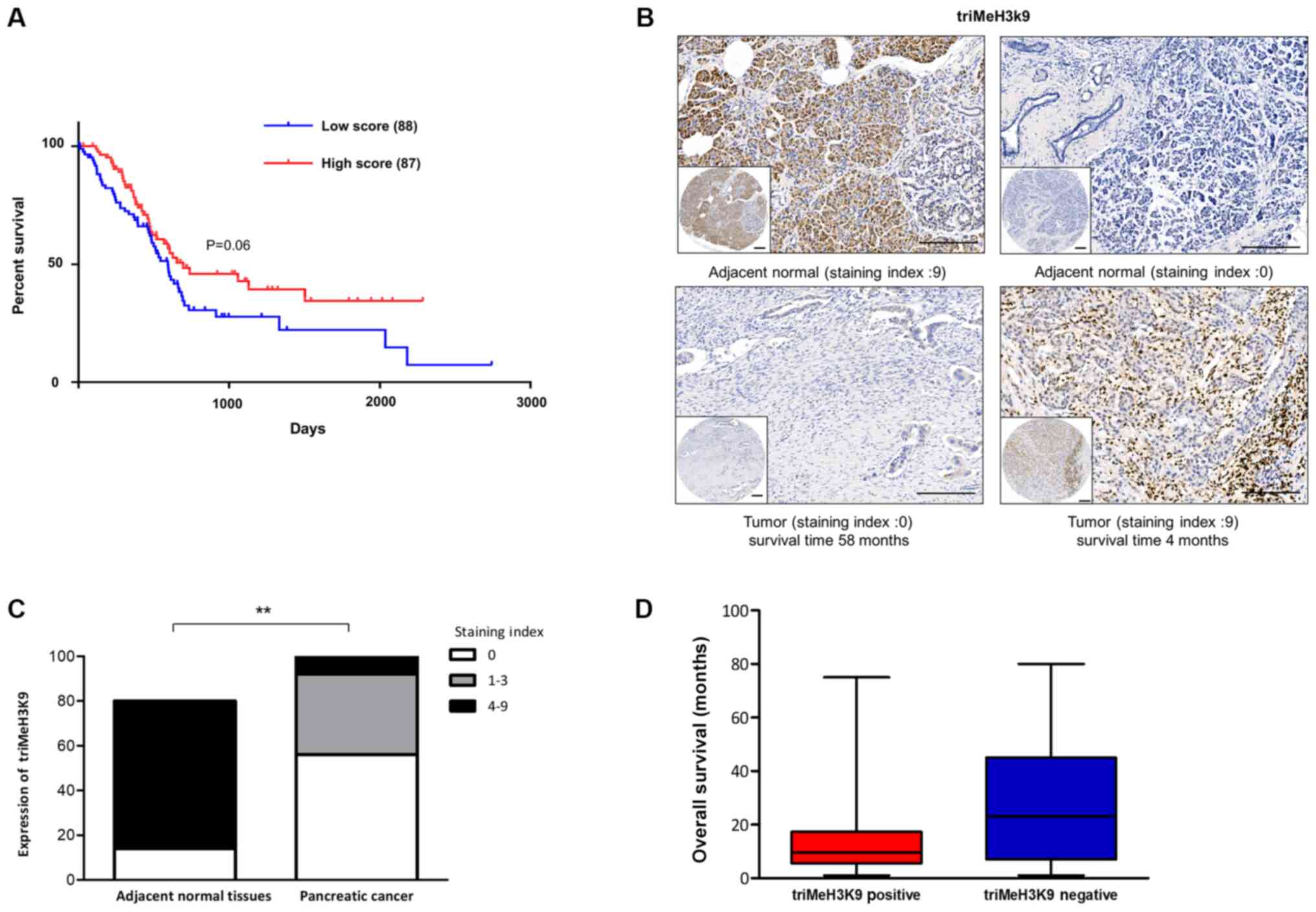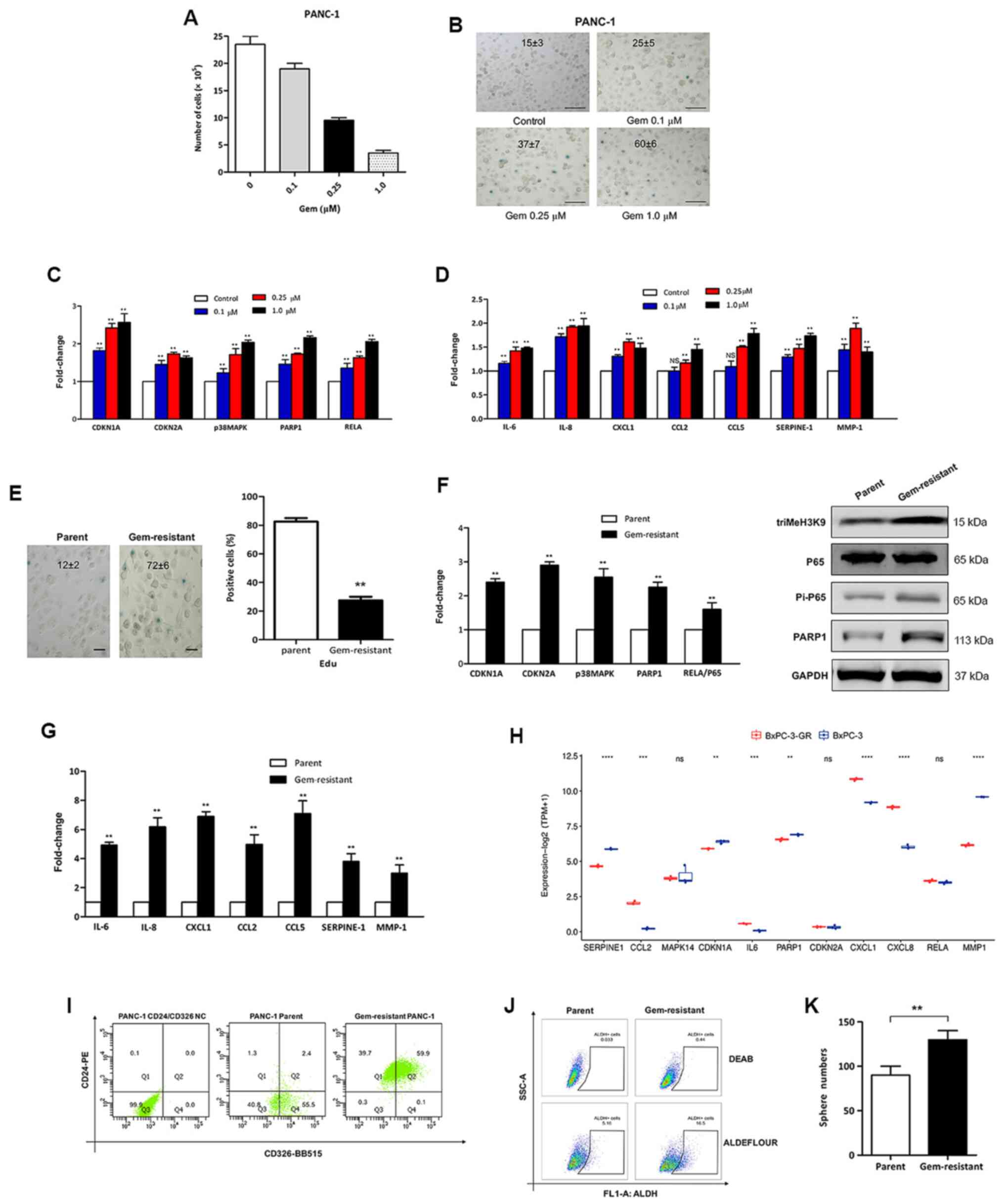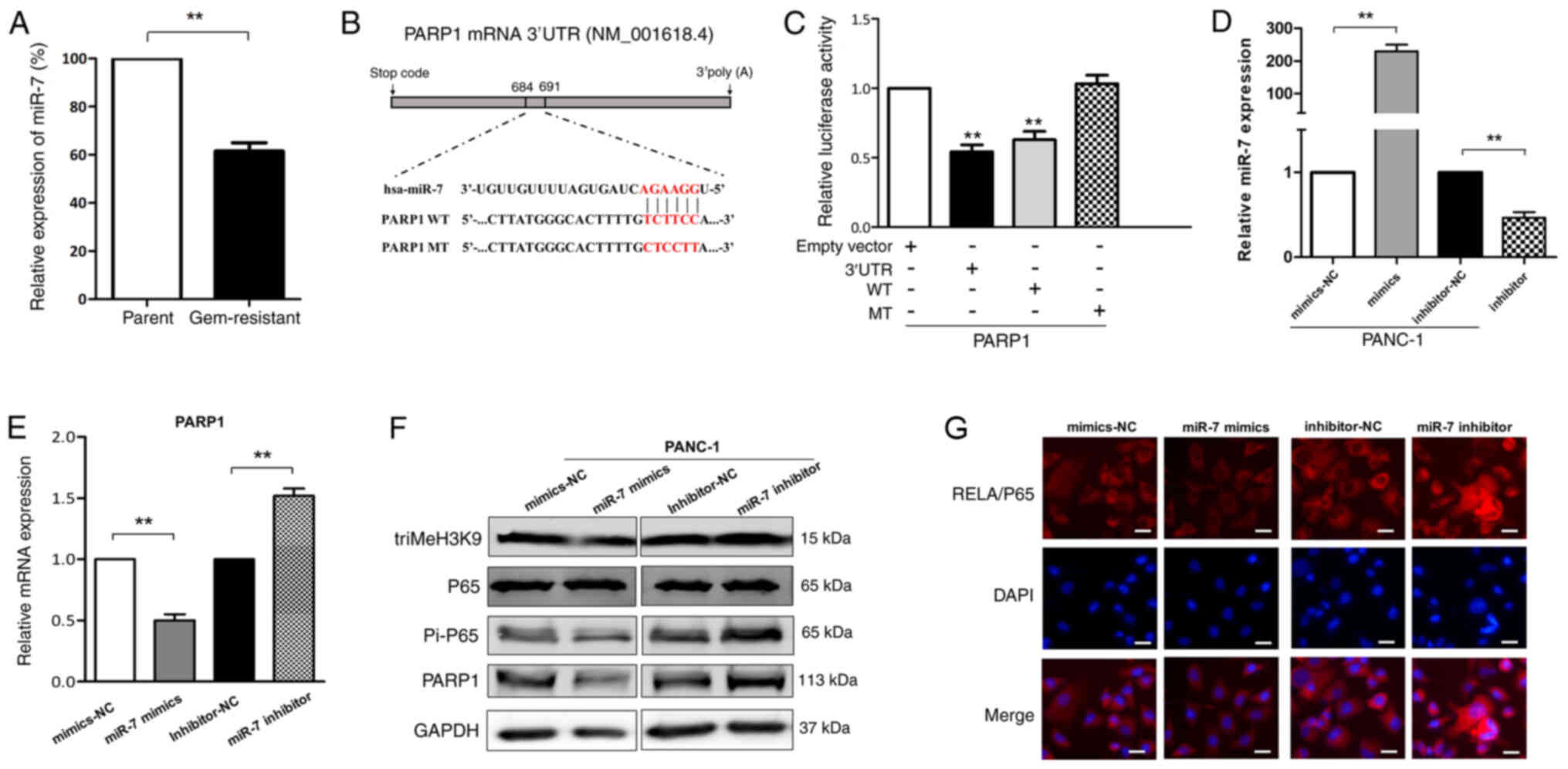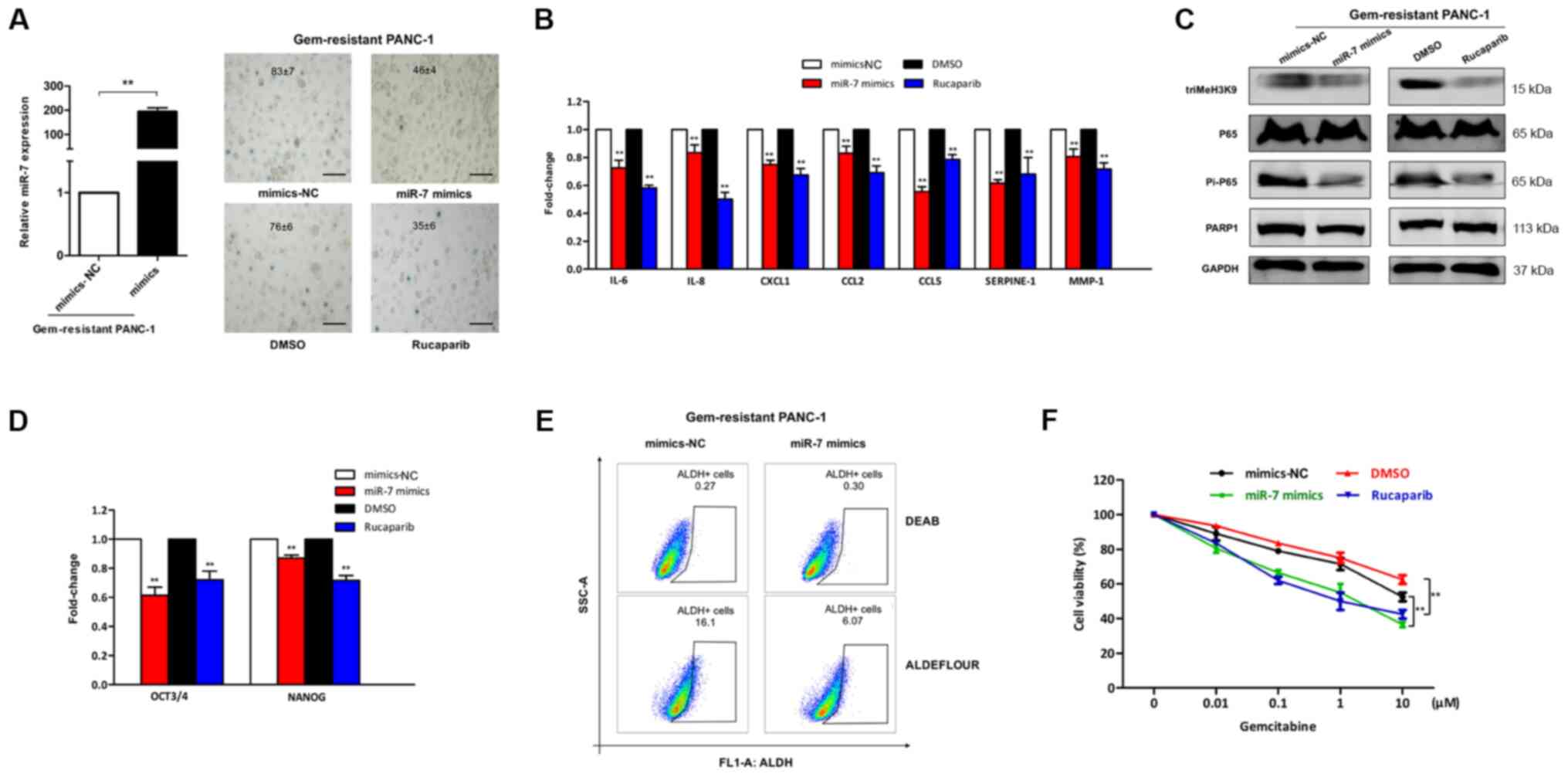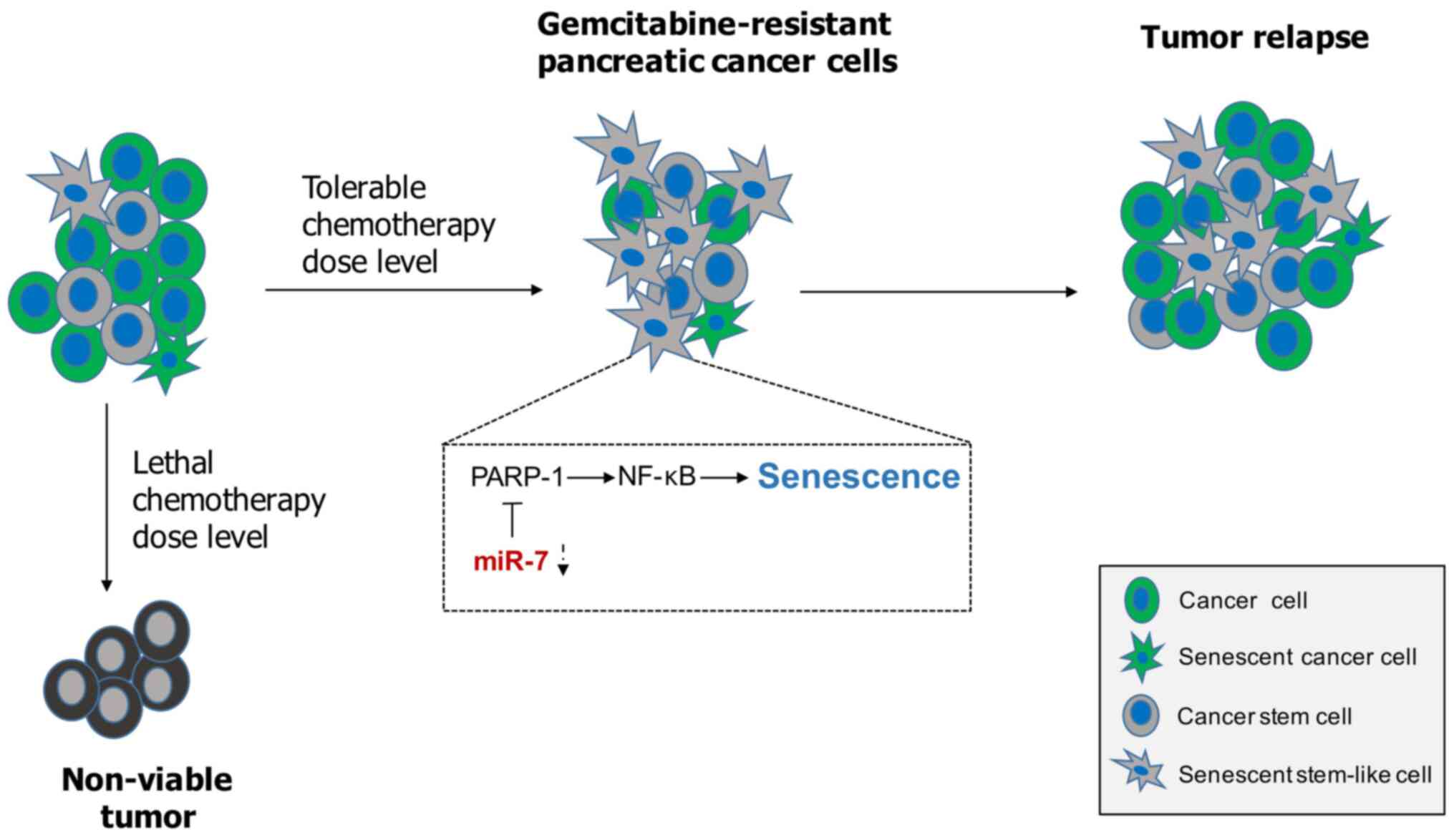|
1
|
Siegel RL, Miller KD and Jemal A: Cancer
statistics, 2019. CA Cancer J Clin. 69:7–34. 2019. View Article : Google Scholar : PubMed/NCBI
|
|
2
|
Neoptolemos JP, Kleeff J, Michl P,
Costello E, Greenhalf W and Palmer DH: Therapeutic developments in
pancreatic cancer: Current and future perspectives. Nat Rev
Gastroenterol Hepatol. 15:333–348. 2018. View Article : Google Scholar : PubMed/NCBI
|
|
3
|
Mohammed S, Van Buren G II and Fisher WE:
Pancreatic cancer: Advances in treatment. World J Gastroenterol.
20:9354–9360. 2014.PubMed/NCBI
|
|
4
|
Marino Gammazza A, Campanella C, Barone R,
Caruso Bavisotto C, Gorska M, Wozniak M, Carini F, Cappello F,
D'Anneo A, Lauricella M, et al: Doxorubicin anti-tumor mechanisms
include Hsp60 post-translational modifications leading to the
Hsp60/p53 complex dissociation and instauration of replicative
senescence. Cancer Lett. 385:75–86. 2017. View Article : Google Scholar : PubMed/NCBI
|
|
5
|
Li W, Wang W, Dong H, Li Y, Li L, Han L,
Han Z, Wang S, Ma D and Wang H: Cisplatin-induced senescence in
ovarian cancer cells is mediated by GRP78. Oncol Rep. 31:2525–2534.
2014. View Article : Google Scholar : PubMed/NCBI
|
|
6
|
Lee JJ, Park IH, Rhee WJ, Kim HS and Shin
JS: HMGB1 modulates the balance between senescence and apoptosis in
response to genotoxic stress. FASEB J. 33:10942–10953. 2019.
View Article : Google Scholar : PubMed/NCBI
|
|
7
|
Perez-Mancera PA, Young AR and Narita M:
Inside and out: The activities of senescence in cancer. Nat Rev
Cancer. 14:547–558. 2014. View
Article : Google Scholar : PubMed/NCBI
|
|
8
|
Dorr JR, Yu Y, Milanovic M, Beuster G,
Zasada C, Däbritz JH, Lisec J, Lenze D, Gerhardt A, Schleicher K,
et al: Synthetic lethal metabolic targeting of cellular senescence
in cancer therapy. Nature. 501:421–425. 2013. View Article : Google Scholar : PubMed/NCBI
|
|
9
|
Kaur A, Webster MR, Marchbank K, Behera R,
Ndoye A, Kugel CH III, Dang VM, Appleton J, O'Connell MP, Cheng P,
et al: sFRP2 in the aged microenvironment drives melanoma
metastasis and therapy resistance. Nature. 532:250–254. 2016.
View Article : Google Scholar : PubMed/NCBI
|
|
10
|
Sun Y, Coppe JP and Lam EW: Cellular
senescence: The sought or the unwanted? Trends Mol Med. 24:871–885.
2018. View Article : Google Scholar : PubMed/NCBI
|
|
11
|
Song Y, Baba T and Mukaida N: Gemcitabine
induces cell senescence in human pancreatic cancer cell lines.
Biochem Biophys Res Commun. 477:515–519. 2016. View Article : Google Scholar : PubMed/NCBI
|
|
12
|
Hua YQ, Zhu YD, Xie GQ, Zhang K, Sheng J,
Zhu ZF, Ning ZY, Chen H, Chen Z, Meng ZQ and Liu LM: Long
non-coding SBF2-AS1 acting as a competing endogenous RNA to sponge
microRNA-142-3p to participate in gemcitabine resistance in
pancreatic cancer via upregulating TWF1. Aging (Albany NY).
11:8860–8878. 2019. View Article : Google Scholar : PubMed/NCBI
|
|
13
|
Williams J, Smith F, Kumar S, Vijayan M
and Reddy PH: Are microRNAs true sensors of ageing and cellular
senescence? Ageing Res Rev. 35:350–363. 2017. View Article : Google Scholar : PubMed/NCBI
|
|
14
|
Gu DN, Jiang MJ, Mei Z, Dai JJ, Dai CY,
Fang C, Huang Q and Tian L: microRNA-7 impairs autophagy-derived
pools of glucose to suppress pancreatic cancer progression. Cancer
Lett. 400:69–78. 2017. View Article : Google Scholar : PubMed/NCBI
|
|
15
|
Luo H, Liang H, Chen Y, Chen S, Xu Y, Xu
L, Liu J, Zhou K, Peng J, Guo G, et al: miR-7-5p overexpression
suppresses cell proliferation and promotes apoptosis through
inhibiting the ability of DNA damage repair of PARP-1 and BRCA1 in
TK6 cells exposed to hydroquinone. Chem Biol Interact. 283:84–90.
2018. View Article : Google Scholar : PubMed/NCBI
|
|
16
|
Lai J, Yang H, Zhu Y, Ruan M, Huang Y and
Zhang Q: MiR-7-5p-mediated downregulation of PARP1 impacts DNA
homologous recombination repair and resistance to doxorubicin in
small cell lung cancer. BMC Cancer. 19:6022019. View Article : Google Scholar : PubMed/NCBI
|
|
17
|
Livak KJ and Schmittgen TD: Analysis of
relative gene expression data using real-time quantitative PCR and
the 2(-Delta Delta C(T)) method. Methods. 25:402–408. 2001.
View Article : Google Scholar : PubMed/NCBI
|
|
18
|
Li L, Hao X, Qin J, Tang W, He F, Smith A,
Zhang M, Simeone DM, Qiao XT, Chen ZN, et al: Antibody against
CD44s inhibits pancreatic tumor initiation and postradiation
recurrence in mice. Gastroenterology. 146:1108–1118. 2014.
View Article : Google Scholar : PubMed/NCBI
|
|
19
|
Zhou J, Zhang L, Zheng H, Ge W, Huang Y,
Yan Y, Zhou X, Zhu W, Kong Y, Ding Y and Wang W: Identification of
chemoresistance-related mRNAs based on gemcitabine-resistant
pancreatic cancer cell lines. Cancer Med. 9:1115–1130. 2020.
View Article : Google Scholar : PubMed/NCBI
|
|
20
|
Cheng Q, Ouyang X, Zhang R, Zhu L and Song
X: Senescence-associated genes and non-coding RNAs function in
pancreatic cancer progression. RNA Biol. 17:1693–1706. 2020.
View Article : Google Scholar : PubMed/NCBI
|
|
21
|
Perez RF, Tejedor JR, Bayon GF, Fernández
AF and Fraga MF: Distinct chromatin signatures of DNA
hypomethylation in aging and cancer. Aging Cell. 17:e127442018.
View Article : Google Scholar : PubMed/NCBI
|
|
22
|
Burris HA III, Moore MJ, Andersen J, Green
MR, Rothenberg ML, Modiano MR, Cripps MC, Portenoy RK, Storniolo
AM, Tarassoff P, et al: Improvements in survival and clinical
benefit with gemcitabine as first-line therapy for patients with
advanced pancreas cancer: A randomized trial. J Clin Oncol.
15:2403–2413. 1997. View Article : Google Scholar : PubMed/NCBI
|
|
23
|
Milanovic M, Fan DNY, Belenki D, Däbritz
JHM, Zhao Z, Yu Y, Dörr JR, Dimitrova L, Lenze D, Monteiro Barbosa
IA, et al: Senescence-associated reprogramming promotes cancer
stemness. Nature. 553:96–100. 2018. View Article : Google Scholar : PubMed/NCBI
|
|
24
|
Ye ZQ, Zou CL, Chen HB, Jiang MJ, Mei Z
and Gu DN: MicroRNA-7 as a potential biomarker for prognosis in
pancreatic cancer. Dis Markers. 2020:27821012020. View Article : Google Scholar : PubMed/NCBI
|
|
25
|
Ohanna M, Giuliano S, Bonet C, Imbert V,
Hofman V, Zangari J, Bille K, Robert C, Bressac-de Paillerets B,
Hofman P, et al: Senescent cells develop a PARP-1 and nuclear
factor-{kappa}B-associated secretome (PNAS). Genes Dev.
25:1245–1261. 2011. View Article : Google Scholar : PubMed/NCBI
|
|
26
|
Suresh B, Lee J, Kim KS and Ramakrishna S:
The importance of ubiquitination and deubiquitination in cellular
reprogramming. Stem Cells Int. 2016:67059272016. View Article : Google Scholar : PubMed/NCBI
|
|
27
|
Dauer P, Nomura A, Saluja A and Banerjee
S: Microenvironment in determining chemo-resistance in pancreatic
cancer: Neighborhood matters. Pancreatology. 17:7–12. 2017.
View Article : Google Scholar : PubMed/NCBI
|
|
28
|
Binenbaum Y, Na'ara S and Gil Z:
Gemcitabine resistance in pancreatic ductal adenocarcinoma. Drug
Resist Updat. 23:55–68. 2015. View Article : Google Scholar : PubMed/NCBI
|
|
29
|
Guillon J, Petit C, Toutain B, Guette C,
Lelièvre E and Coqueret O: Chemotherapy-induced senescence, an
adaptive mechanism driving resistance and tumor heterogeneity. Cell
Cycle. 18:2385–2397. 2019. View Article : Google Scholar : PubMed/NCBI
|
|
30
|
Calcinotto A, Kohli J, Zagato E,
Pellegrini L, Demaria M and Alimonti A: Cellular senescence: Aging,
cancer, and injury. Physiol Rev. 99:1047–1078. 2019. View Article : Google Scholar : PubMed/NCBI
|
|
31
|
Demaria M, O'Leary MN, Chang J, Shao L,
Liu S, Alimirah F, Koenig K, Le C, Mitin N, Deal AM, et al:
Cellular senescence promotes adverse effects of chemotherapy and
cancer relapse. Cancer Discov. 7:165–176. 2017. View Article : Google Scholar : PubMed/NCBI
|
|
32
|
Craske MG and Barlow DH: Nocturnal panic.
J Nerv Ment Dis. 177:160–167. 1989. View Article : Google Scholar : PubMed/NCBI
|
|
33
|
Hamed SS, Straubinger RM and Jusko WJ:
Pharmacodynamic modeling of cell cycle and apoptotic effects of
gemcitabine on pancreatic adenocarcinoma cells. Cancer Chemother
Pharmacol. 72:553–563. 2013. View Article : Google Scholar : PubMed/NCBI
|
|
34
|
Acosta JC, Banito A, Wuestefeld T,
Georgilis A, Janich P, Morton JP, Athineos D, Kang TW, Lasitschka
F, Andrulis M, et al: A complex secretory program orchestrated by
the inflammasome controls paracrine senescence. Nat Cell Biol.
15:978–990. 2013. View Article : Google Scholar : PubMed/NCBI
|



